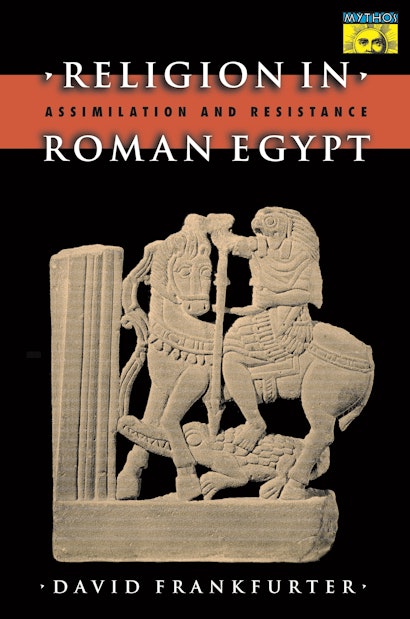This exploration of cultural resilience examines the complex fate of classical Egyptian religion during the centuries from the period when Christianity first made its appearance in Egypt to when it became the region’s dominant religion (roughly 100 to 600 C.E. Taking into account the full range of witnesses to continuing native piety—from papyri and saints’ lives to archaeology and terracotta figurines—and drawing on anthropological studies of folk religion, David Frankfurter argues that the religion of Pharonic Egypt did not die out as early as has been supposed but was instead relegated from political centers to village and home, where it continued a vigorous existence for centuries.
In analyzing the fate of the Egyptian oracle and of the priesthoods, the function of magical texts, and the dynamics of domestic cults, Frankfurter describes how an ancient culture maintained itself while also being transformed through influences such as Hellenism, Roman government, and Christian dominance. Recognizing the special characteristics of Egypt, which differentiated it from the other Mediterranean cultures that were undergoing simultaneous social and political changes, he departs from the traditional “decline of paganism/triumph of Christianity” model most often used to describe the Roman period. By revealing late Egyptian religion in its Egyptian historical context, he moves us away from scenarios of Christian triumph and shows us how long and how energetically pagan worship survived.
Awards and Recognition
- Winner of the 1999 Award for Excellence in the Study of Religion, Historical Studies category, of the American Academy of Religion
David Frankfurter is Associate Professor of History and Religious Studies at the University of New Hampshire. He is the author of Elijah in Upper Egypt: The Apocalypse of Elijah and Early Egyptian Christianity.
"Frankfurter presents a new and convincing analysis of the history of religious change in Roman and early Byzantine Egypt. . . . This new synthesis of the available evidence constitutes a real breakthrough in our understanding of the religious changes in late ancient Egypt attending its Christianization."—Birger A. Pearson, Religious Studies Review
"An exemplary work, engagingly written, which will be of interest not only to students of late antiquity, early Christianity, and Egypt but to anyone concerned with issues of religious change and practice."—Jonathan P. Berkey, American Historical Review
"Where it has been usual to focus on the decay of grand temple religion, Frankfurter argues that this is only one side of the matter. There remained a lively practice of popular and local religion. . . . The book overflows with ideas and insights."—Richard Gordon, Times Literary Supplement
"Stimulating in the very best sense of that word: its thickly packed details and formulations reward readers not only with the insights of its author, but with material that often prompts them to travel down new paths of though themselves."—Sarah Iles Johnston, Journal of Biblical Literature
"This ambitious book rewards the specialist and nonspecialist alike with a rich overview of Egyptian religion in late antiquity within a comparative religion framework. . . . Frankfurter's refreshing synthesis of religion and magic both rewards and illumines the reader. His dexterity with such a diversity of visual, material, and textual evidence is a hallmark of this erudite book. . . . Generously illustrated and clearly organized, this thought provoking study has set a benchmark for future work on religion in the ancient Mediterranean."—Georgia Frank, Journal of the American Academy of Religion
"This ambitious book rewards the specialist and nonspecialist alike with a rich overview of Egyptian religion in late antiquity within a comparative religion framework. . . . Frankfurter's refreshing synthesis of religion and magic both rewards and illumines the reader. His dexterity with such a diversity of visual, material, and textual evidence is a hallmark of this erudite book. . . . Generously illustrated and clearly organized, this thought-provoking study has set a benchmark for future work on religion in the ancient Mediterranean."—Georgia Frank, Journal of the American Academy of Religion
"Popular religion is at the center of this excellent study. Frankfurter places Christianity in a multifaceted, often unexpected context in the countryside of Egypt. He shows that despite the state's new religion, Egyptian gods, goddesses, and cultic practices persisted. The result is a thoroughly stimulating book—-an unusual mix of erudition and interpretation—and one which I read with great pleasure."—Dorothy J. Thompson, Girton College, Cambridge
"Clearly written and well-researched, [Frankfurter's] book is accessible to a wide audience of scholars and lay people alike."—J. G. Manning, Stanford University


